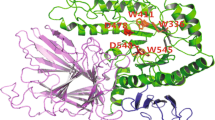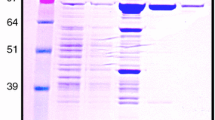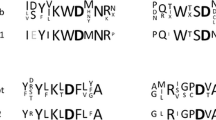Abstract
A recombinant β-galactosidase from Caldicellulosiruptor saccharolyticus was purified with a specific activity of 211 U mg−1 by using heat treatment and His-trap affinity chromatography. The native enzyme was an 80-kDa trimer with a molecular mass of 240 kDa. Maximum activity was observed at pH 6.0 and 80ºC, and the half-life at 70ºC was 48 h. The enzyme exhibited hydrolytic activity for p-nitrophenyl-β-d-galactopyranoside (pNPGal), oNPGal, or lactose, whereas no activity for p-nitrophenyl-β-d-glucopyranoside (pNPGlu), oNPGlu, or cellobiose. The catalytic residues E150 and E311 of β-galactosidase from C. saccharolyticus were completely conserved in all aligned glycoside hydrolase family 42 β-galactosidases. The results indicated that the enzyme was a β-galactosidase. Galactose uncompetitively inhibited the enzyme. Glucose inhibition of the enzyme was the lowest among β-galactosidases. When 50 g l−1 galactose was added, the enzyme activity for pNPGal was reduced to 26%. When 400 g l−1 glucose instead of galactose was added, the activity was reduced to 82%. When adding galactose (200 g l−1), only 14% of the lactose was hydrolyzed after 180 min. In contrast, the addition of glucose (400 g l−1) did not affect lactose hydrolysis, and more than 99% of the lactose was hydrolyzed after 120 min.






Similar content being viewed by others
References
Coker JA, Sheridan PP, Loveland-Curtze J, Gutshall KR, Auman AJ, Brenchley JE (2003) Biochemical characterization of a β-galactosidase with a low temperature optimum obtained from an antarctic Arthrobacter isolate. J Bacteriol 185:5473–5482
Cornish-Bowden A (1974) A simple graphical method for determining the inhibition constants of mixed, uncompetitive and non-competitive inhibitors. Biochem J 137:143–144
Davies G, Henrissat B (1995) Structures and mechanisms of glycosyl hydrolases. Structure 3:853–859
de Alcântara PH, Martim L, Silva CO, Dietrich SM, Buckeridge MS (2006) Purification of a β-galactosidase from cotyledons of Hymenaea courbaril L. (Leguminosae). Enzyme properties and biological function. Plant Physiol Biochem 44:619–627
Di Lauro B, Strazzulli A, Perugino G, La Cara F, Bedini E, Corsaro MM, Rossi M, Moracci M (2008) Isolation and characterization of a new family 42 β-galactosidase from the thermoacidophilic bacterium Alicyclobacillus acidocaldarius: identification of the active site residues. Biochim Biophys Acta 1784:292–301
Durand P, Lehn P, Callebaut I, Fabrega S, Henrissat B, Mornon JP (1997) Active-site motifs of lysosomal acid hydrolases: invariant features of clan GH-A glycosyl hydrolases deduced from hydrophobic cluster analysis. Glycobiology 7:277–284
Haider T, Husain Q (2007) Calcium alginate entrapped preparations of Aspergillus oryzae β-galactosidase: its stability and applications in the hydrolysis of lactose. Int J Biol Macromol 41:72–80
Haki GD, Rakshit SK (2003) Developments in industrially important thermostable enzymes: a review. Bioresour Technol 89:17–34
Henrissat B (1991) A classification of glycosyl hydrolases based on amino acid sequence similarities. Biochem J 280(Pt 2):309–316
Hidaka M, Fushinobu S, Ohtsu N, Motoshima H, Matsuzawa H, Shoun H, Wakagi T (2002) Trimeric crystal structure of the glycoside hydrolase family 42 β-galactosidase from Thermus thermophilus A4 and the structure of its complex with galactose. J Mol Biol 322:79–91
Hinz SW, van den Brock LA, Beldman G, Vincken JP, Voragen AG (2004) β-Galactosidase from Bifidobacterium adolescentis DSM20083 prefers β(1, 4)-galactosides over lactose. Appl Microbiol Biotechnol 66:276–284
Hong MR, Park CS, Oh DK (2009) Characterization of a thermostable endo-1,5-α-l-arabinanase from Caldicellulorsiruptor saccharolyticus. Biotechnol Lett. doi:10.1007/s10529-009-0019-0
Ji ES, Park NH, Oh DK (2005) Galacto-oligosaccharide production by a thermostable recombinant β-galactosidase from Thermotoga maritima. World J Microbiol Biotechnol 21:759–764
Kim CS, Ji ES, Oh DK (2004a) Characterization of a thermostable recombinant β-galactosidase from Thermotoga maritima. J Appl Microbiol 97:1006–1014
Kim CS, Ji ES, Oh DK (2004b) A new kinetic model of recombinant β-galactosidase from Kluyveromyces lactis for both hydrolysis and transgalactosylation reactions. Biochem Biophys Res Commun 316:738–743
Ladero M, Perez MT, Santos A, Garcia-Ochoa F (2003) Hydrolysis of lactose by free and immobilized β-galactosidase from Thermus sp. strain T2. Biotechnol Bioeng 81:241–252
Mateo C, Monti R, Pessela BCC, Fuentes M, Torres R, Guisan JM, Fernandez-Lafuente R (2004) Immobilization of lactase from Kluyveromyces lactis greatly reduces the inhibition promoted by glucose. Full hydrolysis of lactose in milk. Biotechnol Prog 20:1259–1262
Moller PL, Jorgensen F, Hansen OC, Madsen SM, Stougaard P (2001) Intra- and extracellular β-galactosidases from Bifidobacterium bifidum and B. infantis: molecular cloning, heterologous expression, and comparative characterization. Appl Environ Microbiol 67:2276–2283
Nagy Z, Kiss T, Szentirmai A, Biro S (2001) β-Galactosidase of Penicillium chrysogenum: production, purification, and characterization of the enzyme. Protein Expr Purif 21:24–29
Nakkharat P, Haltrich D (2006) Purification and characterisation of an intracellular enzyme with β-glucosidase and β-galactosidase activity from the thermophilic fungus Talaromyces thermophilus CBS 236.58. J Biotechnol 123:304–313
Nguyen TH, Splechtna B, Steinbock M, Kneifel W, Lettner HP, Kulbe KD, Haltrich D (2006) Purification and characterization of two novel β-galactosidases from Lactobacillus reuteri. J Agric Food Chem 54:4989–4998
Pessela BCC, Mateo C, Fuentes M, Vian A, García JL, Carrascosa AV, Guisán JM, Fernández-Lafuente R (2003) The immobilization of a thermophilic β-galactosidase on sepabeads supports decrease product inhibition complete hydrolysis of lactose in dairy products. Enzyme Microb Technol 33:199–205
Petzelbauer I, Nidetzky B, Haltrich D, Kulbe KD (1999) Development of an ultra-high-temperature process for the enzymatic hydrolysis of lactose. I. The properties of two thermostable β-glycosidases. Biotechnol Bioeng 64:322–332
Phan Tran LS, Szabo L, Fulop L, Orosz L, Sik T, Holczinger A (1998) Isolation of a β-galactosidase-encoding gene from Bacillus licheniformis: purification and characterization of the recombinant enzyme expressed in Escherichia coli. Curr Microbiol 37:39–43
Pisani FM, Rella R, Raia CA, Rozzo C, Nucci R, Gambacorta A, De Rosa M, Rossi M (1990) Thermostable β-galactosidase from the archaebacterium Sulfolobus solfataricus. Purification and properties. Eur J Biochem 187:321–328
Rainey FA, Donnison AM, Janssen PH, Saul D, Rodrigo A, Bergquist PL, Daniel RM, Stackebrandt E, Morgan HW (1994) Description of Caldicellulosiruptor saccharolyticus gen. nov., sp. nov: an obligately anaerobic, extremely thermophilic, cellulolytic bacterium. FEMS Microbiol Lett 120:263–266
Shuler ML, Kargi F (2002) Bioprocess engineering, basic concepts, 2nd edn. Prentice Hall PTR, New York
van de Werken HJ, Verhaart MR, VanFossen AL, Willquist K, Lewis DL, Nichols JD, Goorissen HP, Mongodin EF, Nelson KE, van Niel EW, Stams AJ, Ward DE, de Vos WM, van der Oost J, Kelly RM, Kengen SW (2008) Hydrogenomics of the extremely thermophilic bacterium Caldicellulosiruptor saccharolyticus. Appl Environ Microbiol 74:6720–6729
Xiong AS, Peng RH, Zhuang J, Li X, Xue Y, Liu JG, Gao F, Cai B, Chen JM, Yao QH (2007) Directed evolution of a β-galactosidase from Pyrococcus woesei resulting in increased thermostable β-glucuronidase activity. Appl Microbiol Biotechnol 77:569–578
Acknowledgment
This study was carried out with the support of the 21C Frontier Project for Microbial Genomics, Ministry of Education, Science and Technology.
Author information
Authors and Affiliations
Corresponding author
Rights and permissions
About this article
Cite this article
Park, AR., Oh, DK. Effects of galactose and glucose on the hydrolysis reaction of a thermostable β-galactosidase from Caldicellulosiruptor saccharolyticus . Appl Microbiol Biotechnol 85, 1427–1435 (2010). https://doi.org/10.1007/s00253-009-2165-7
Received:
Revised:
Accepted:
Published:
Issue Date:
DOI: https://doi.org/10.1007/s00253-009-2165-7




